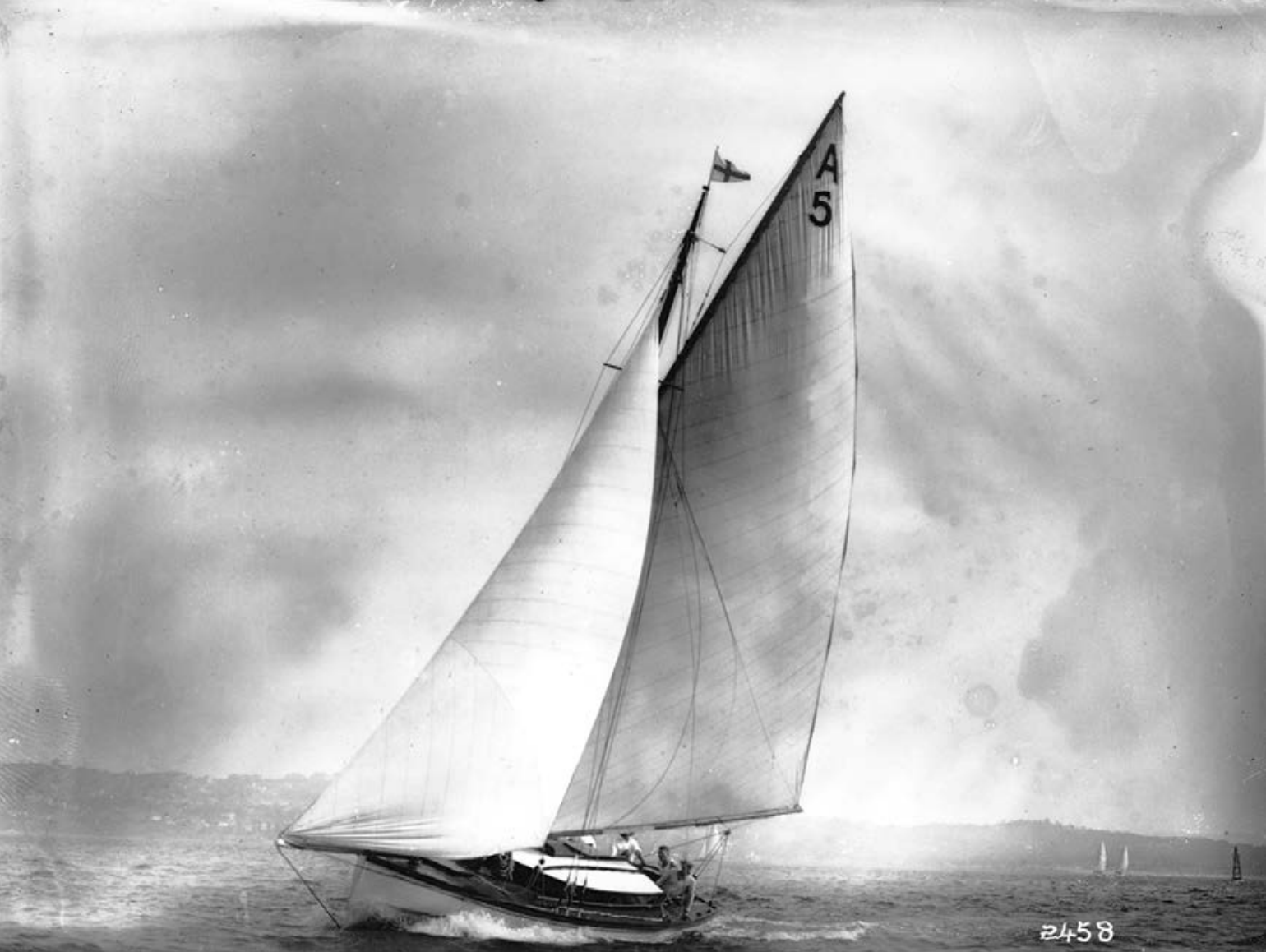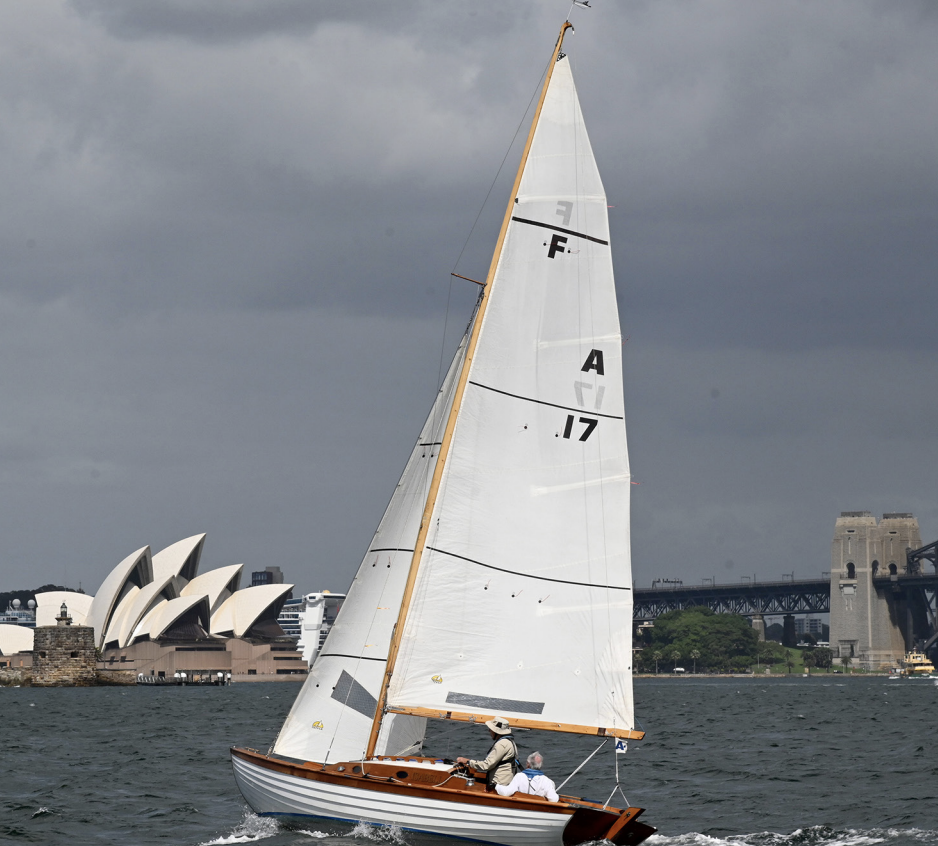Mmmm, the plot thickened. Sometime later, Simon Sadubin of Sydney Wooden Boats, while doing a major rebuild after an accident, found a picture from an old January 1925 magazine titled “Sydney’s Latest Cruiser.” To be safe, I’ve decided that 1925 is her hazy launch date. What is it with these hoary old memes, ‘the fog of war’ — ‘the mists of time’? I’ll tell you what it is: “its entropy!” One of Simon’s favourite chestnuts, “Wooden boats are entropy Squared!” So what keeps a wooden boat alive for one hundred years, fighting off that ruthless multiplication?
Many factors conspire against it. A traditionally-built wooden boat is essentially an elegant basket of sticks fastened together at crucial junctures with pins of various sizes. It’s launched into a hostile environment which takes no prisoners, suffering relentless attacks from above and below. One half is exposed to UV, dehydration and freshwater rot, the other half is saturated by a corrosive solution, prone to decay, and attacked by burrowing organisms. Then there are the elements! Air is hell-bent on furiously dismantling everything sticking up. Water is equally hell-bent on twisting and penetrating anything sticking down. Earth awaits to be struck upon. Fire has consumed countless craft. Ultimately, though, it all comes down to ‘foibles’.
Ownership of an old wooden boat is a foible, a “minor weakness or eccentricity,” as the dictionary would have it. Possibly the most critical factor in a vessel’s longevity is a historical absence of extreme foibles from previous owners. From serious neglect; down to, I’ll just stick a bit of bog in it; any old screw will do; let’s wack a big anode down there and see what happens. You know the story. So, it appears the ideal owner is prone to foibles but within the bounds of reason. Except, you and I both know, nothing is reasonable about a commitment to an old wooden boat, especially one approaching one hundred years old. After a somewhat rambling introduction, I’m finally getting to the point of my story.
A few weeks ago, Hoana’s faithful little engine rewarded my annual service by dumping the contents of its sump into the bilge. Thirty-six years that little Nanni ran sweetly, it still ran sweetly, when, with a recharge of oil and another quarter turn on the new oil filter, I started it up again…. Nup, something more dastardly was afoot! A mechanic friend explained that the new oil had probably dislodged a patch of old oil plaque covering some rust hole somewhere. Unfortunately, ‘somewhere’ was both unreachable and unseeable.
in the bilge is one of life’s more groan-worthy occurrences. Yes, I did June 2024 groan! The groaning got louder when I realised that the only way I would find out where it was coming from was to pull the engine out of the boat. And that, dear reader, is when the slope got slippery. Perhaps at this time, if you’re sitting comfortably, hopefully in the saloon of your timber boat, with the soft slap and ripple aided and abetted by gentle sips of a peaty old whisky, your enquiring mind will take you to the fascinating https://en.wikipedia.org/wiki/List_of_ fallacies of which the ‘Slippery Slope’ is one. It starts with an internal argument between Mr Foible and Mr Reason. Mr Reason categorically states that throwing a lot of money into a boat on the cusp of its century is itself a perfect example of the ‘Sunk Cost Fallacy’ — it follows therefore, that repairing and reinstalling the engine which has been perfectly adequate for almost every eventuality for thirty-six years is the only cost-effective solution. We know it fits, runs beautifully, is less than halfway through its nominal, engine hour life, and can be fixed; Mr Foible, on the other hand, has his own ideas!
A common foible amongst hominids is ‘Horsepower’. It can be the kiss of death for a floating basket of sticks. That thrust vector is all well and good in a straight line on flat water. Throw a tight turn in a vicious chop; said vector is wildly oscillating, wracking throughout the entire structure. It was why I’d chosen a modest fifteen for the Nanni when replacing the 1932 20HP Utility Four that came with the boat. This charming historical artefact required muttered incantations every time the key was turned, followed by loud imprecations when resorting to the crank handle. Replacing that explosive mass of cast iron and its concomitant forepeak trimming ballast led to a sigh of relief (and a cruel tweaking of her handicap) as she rose two inches on her waterlines.
Mr Foible then made his case: The whole exercise of classic boat ownership is a Sunk Cost Fallacy. Go the whole hog! The Nanni fifteen had gone in when her old bones were a little weary; a lifetime of racing and a world circumnavigation will do that. But thirty-six years later, with nearly every frame in her Kauri hull replaced and refastened, many floors added or replaced, a new Jarrah bridge deck beam, hanging knees, lodging knees, engine bearers, running gear, the list goes on, she was substantially renewed, restrengthened, and ready again for the extra horses.
My partner is convinced that my demanding mistress has a mind of her own. When told the engine needed removal, she said, “Of course! She wants new Bling; her big birthday is coming up!” After letting that statement settle into its rightful place on the astral plane, I informed her of my horsepower foible. “Safety First,” was the cut through response. With less than a month between oil in the bilge and sea trials, the new Beta three cylinder shallow-sump 20HP was chosen between equally robust competitors because it was the only one that fitted the existing engine bearer arrangement. The weight difference between old and new engines is more than compensated by replacing 36kg of Lead Acid batteries with 12kg of LiFePo4 Lithium. Her slippery hull now slopes along most satisfactorily, shrugging off Southerly Busters and Wicked Westerlies. With her next century coming up fast; bringing with it an ever more unpredictable climate regime, Mr Reason has to grudgingly admit, ‘Safety First,’ is no foible.
No matter how often one takes the stairs down from one Green Street, or the tender ride from the Green Shed, the site of the Amateurs’ club house rarely fails to lift one’s spirits. Our unique position on Sydney Harbour’s foreshore, the history of the site and its place in the community are at the heart of our Club. As the Amateurs prepares a new starter’s boat (enlisting the passion and expertise of some dedicated volunteers in true club style), it is fitting that the name of this new vessel should also in some way capture the spirit of who we are. Kareela pays homage to our place in the Harbour — from the road so many us drive down today, to the maritime history of the Mosman Bay and the indigenous history of the area.
The photo below, located by John Jeremy, puts much into perspective, a gallant gaff-rigger, a ferry named Kareela and a view across the harbour from Mosman Bay. While Captain Amora has served us well in name and spirit, the debate between the names of other great captains, other historic boats, and many great club stalwarts (too many of each to choose from with all equally deserving) — and the mariner’s superstition of never changing a name at all — has presented a good natured and sometimes spirited challenge in recent weeks After much consideration your Board settled on Kareela, hoping that, as you wave to the starters before each race, and imagine that was a hooter you heard as you crossed the finish line, the name Kareela will give you that same reminder of our special place on Sydney Harbour, as well as our investment in the future of racing at the Club.
John Brady

During her long service on the Mosman/Neutral Bay run from 1905 to 1959, the ferry Kareela must have berthed at the Old Cremorne Wharf, where the SASC clubhouse and wharf now stand, many, many times.The yacht in this photograph is believed to be Athene




